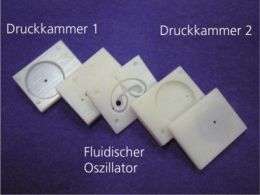The fluid transducer: Electricity from gas and water

Air compression systems can be found in many manufacturing operations. If a leak occurs anywhere in the system, the air pressure drops and production comes to a halt until the source of failure has been found. Sensors constantly monitor the pressure in order to keep costly fault-related losses to a minimum.
At present, these sensors are either battery-driven or connected up by complex technical wiring. This often makes it very difficult or even impossible to install sensors in places that are hard to reach. Fraunhofer researchers from Stuttgart, Germany, have developed a new technology that enables the production of energy-autonomous and thus low-maintenance sensors.
"Our system is eminently suitable for sensors in pneumatic plants, as we can convert the kinetic energy from air or water into electricity," explains José Israel Ramirez, who is doing research on this topic at the TEG. "The fluidic energy transducer generates electricity in the microwatt or milliwatt range. This is sufficient to supply cyclically operating sensors with enough energy to read out and transmit the relevant data."
The fluid-electricity conversion takes place in a fixed housing, through which the medium is fed on a course similar to that of blood circulating in the heart. The Coandã effect causes the constant stream of fluid to oscillate. This produces a periodic pressure fluctuation in the feedback branches, which are coupled to piezoceramics. "The piezoceramics convert the fluidic energy into electricity," says group leader Axel Bindel, summarizing the principle. This fluidic conversion is simple and cost-efficient. " We have the advantage that both air and water can be used to generate energy.
What's more, we don't have any movable parts in our system. The structure can be produced in simple processes, and that saves costs." The new technique can be applied to any system in which a fluid or a gas is guided through a fixed geometry – in supply networks or in medical engineering, for example. "Our objective is to be able to provide currently battery-driven devices, such as water meters, with an autonomous supply of energy in the near future, resulting in completely independent systems," says Bindel. The TEG researchers will be presenting a prototype of the fluid transducer at the joint Fraunhofer stand at the electronica trade fair.
Source: Fraunhofer-Gesellschaft





















